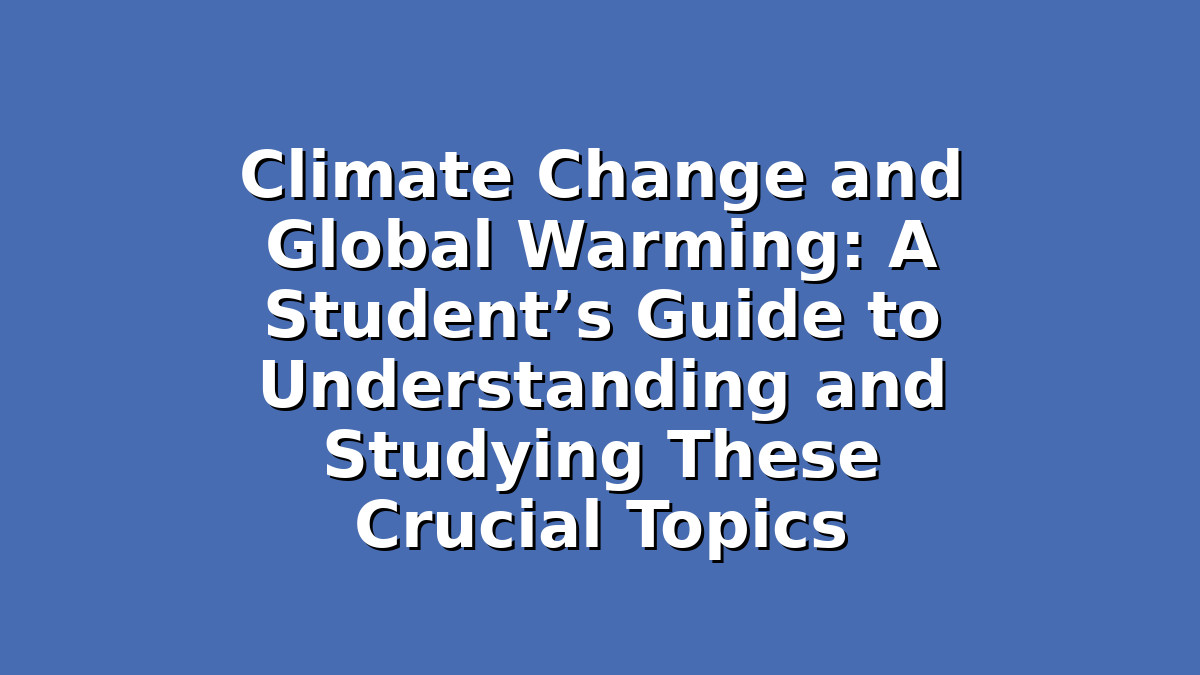Climate change and global warming are two of the most important and urgent issues facing our planet today. As students preparing for exams, essays, or projects, having a clear understanding of these concepts is essential—not only for your academic success but also for becoming an informed global citizen. This guide will help you grasp the key ideas behind climate change and global warming while offering effective study strategies tailored to these topics. Whether you’re tackling science subjects, geography, or environmental studies, this article will support your learning journey with clear explanations and practical tips.
Understanding Climate Change and Global Warming: The Basics
Before diving into study strategies, it’s crucial to understand what climate change and global warming actually mean. Global warming refers to the long-term increase in Earth’s average surface temperature due to human activities, primarily the emission of greenhouse gases like carbon dioxide (CO2) and methane (CH4). These gases trap heat in the atmosphere, causing temperatures to rise.
Climate change, on the other hand, is a broader term that includes global warming but also encompasses other changes in weather patterns, such as shifts in rainfall, increased frequency of extreme weather events, and rising sea levels. These changes affect ecosystems, human health, agriculture, and economies worldwide.
Knowing that global warming is one aspect of climate change helps you see the bigger picture when studying these topics. As you prepare for exams, focus on how human activities contribute to these changes, the impacts on the natural world, and the solutions being pursued globally.
Section 1: Effective Note-Taking and Concept Mapping
One of the biggest challenges when studying climate change and global warming is the vast amount of information, including scientific data, terminology, and current events. To manage this, effective note-taking is your first step.
– Use the Cornell Method: Divide your page into three sections—notes, cues, and summary. Write your detailed notes during lectures or while reading textbooks. In the cue column, jot down keywords like “greenhouse effect,” “carbon footprint,” or “renewable energy.” Later, use these cues to quiz yourself.
– Create Concept Maps: Climate change involves many interconnected factors. Drawing concept maps can help you visualize relationships between ideas, such as how fossil fuel combustion leads to CO2 emissions, which then contribute to global warming and its effects on glaciers and sea levels.
– Highlight Definitions and Key Terms: Terms like “mitigation,” “adaptation,” and “carbon sequestration” are commonly tested. Make sure you have clear definitions and examples noted down.
By organizing your notes effectively, you create a study resource that is easy to review and helps reinforce your understanding.
Section 2: Incorporating Current Events and Real-World Examples
Examiners often look for students who can relate textbook knowledge to real situations. Climate change is a rapidly evolving topic with frequent news updates about policies, scientific discoveries, and environmental impacts. Incorporating current events into your study routine makes your answers more relevant and insightful.
– Follow Reliable News Sources: Websites like NASA Climate Change, the United Nations Environment Programme, and major news outlets have dedicated climate sections. Make it a habit to read one or two articles weekly.
– Use Case Studies: Examples like the Australian bushfires, melting Arctic ice, or initiatives like the Paris Agreement provide concrete cases to explain climate concepts. When writing essays or answering questions, these examples strengthen your arguments.
– Discuss with Peers or Teachers: Sharing recent findings or news during study groups or class discussions helps you retain information and see different perspectives.
Combining theoretical knowledge with up-to-date information shows examiners that you are engaged and informed about ongoing global challenges.
Section 3: Practice with Past Papers and Active Recall Techniques
To excel in exams, understanding concepts is not enough—you need to apply your knowledge confidently. Practicing with past papers and using active recall methods will boost your memory and improve exam performance.
– Use Past Exam Questions: Look for questions related to climate change and global warming from previous exams. Practice answering them within the time limit. This helps you get familiar with question formats and the depth of answers expected.
– Teach What You’ve Learned: Explaining concepts aloud, as if teaching someone else, consolidates your understanding. Try recording yourself or discussing topics with a study buddy.
– Flashcards for Key Facts: Create flashcards for important data, such as the main greenhouse gases, their sources, or key international agreements. Regularly test yourself to keep information fresh.
– Mindful Revision: Instead of passively rereading notes, actively quiz yourself or write summaries from memory. This active recall strengthens neural connections and enhances long-term retention.
By incorporating these active study techniques, you enhance your ability to retrieve information quickly and accurately during exams.
Conclusion: Stay Motivated and Curious
Studying climate change and global warming can sometimes feel overwhelming because of the complexity and urgency of the topic. Remember to break down the information into manageable parts, use effective study methods like note-taking, concept mapping, and active recall, and connect your learning to real-world examples. Staying curious and motivated will not only help you prepare for exams but also empower you to become a thoughtful and responsible global citizen.
Keep in mind that every bit of knowledge you gain contributes to a larger understanding of how our planet works and what can be done to protect it. With the right strategies and a positive mindset, you can master these important topics and make your study time more productive and rewarding.
Good luck with your exams and keep pushing forward—you’ve got this!

Responses